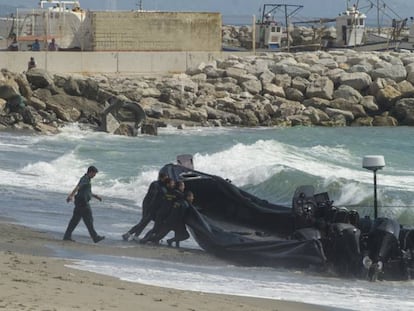How Spain is losing the war against the drug trade in the south
In a part of Cádiz province known as Campo de Gibraltar – adjacent to the British overseas territory – an old battle for control of the drug trade is being waged more aggressively than ever before. Operators in the area carry out their deals with a feeling of impunity, while law enforcement agencies do their best to fight a war that they admit to be losing, for now at least. The following is the story of the ongoing battle from both sides of the trenches.
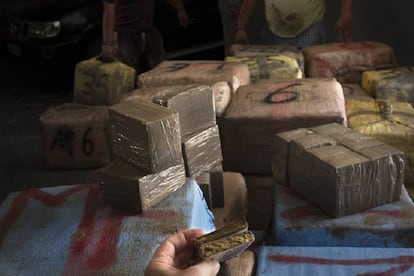
Lying under the bright glow of two spotlights that attract swarms of mosquitoes, the 12-meter-long inflatable speedboat displays its dark and menacing bow, reminiscent of a shark’s jaws. Three outboard motors with 300 horsepower each are affixed to the stern. A blue tarpaulin conceals half of the vessel, including the control center and three rear seats. A radar sits atop a small stainless steel mast. Four helmets are attached to an iron bar, ready to protect the heads of passengers who will skim over the water at speeds of 50 knots and above. Around 50 fuel containers are neatly piled on the ground.
All of these items are concealed inside an ample warehouse with a zinc roof that still has enough space for another speedboat – one that is currently still in the garden of a beachfront home at Playa de Palmones. This twin vessel has an even more powerful propulsion system: three 350 HP engines. It is also still dripping salt water: only two hours ago, both were spotted near the Punta Carbonera lighthouse in San Roque, along the Mediterranean coast of Cádiz.
Under a dim moonlight, the drug smugglers load their goods at a spot near the lighthouse and race towards Palmones beach, in the Bay of Algeciras. The gate of the beachfront house opens up to let out a tractor that hauls the speedboats inside the property. Several individuals immediately scatter into the darkness, four more walk into the property, and a fifth remains out in the garden, unaware that a customs surveillance helicopter is observing the entire operation on a thermal imaging camera hundreds of meters up in the air.
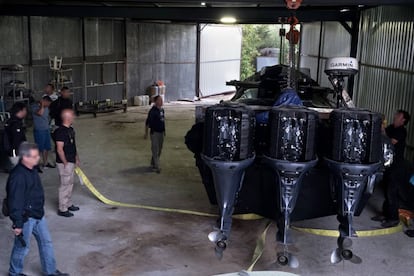
Francis, Iván and Félix are the first to spot the suspect boats. All three customs officers have been scrutinizing the horizon from a hilltop with another infrared camera, sweeping the line that stretches from the Gibraltar border to the port of Sotogrande. When both gomas, as the boats are known, show up near land on the camera screen, Francis radios the helicopter, which quickly identifies the drop-off point. An alert also goes out to the command center that coordinates the work of several law enforcement agencies. Several Civil Guard officers, including members of the elite Rapid Action Group (GAR), secure the perimeter of the home before the customs officers show up.
When the raid begins, the only person who appears to be inside the house is a middle-aged man in brown fatigues who claims that he is just a tenant and knows nothing about the large boats dripping water on the property. Four more individuals finally emerge from the house at the crack of dawn. Two of them say they are from Ceuta, the Spanish exclave city on the northern coast of Africa. Two more hail from Cádiz province. The oldest one is chain smoking, while the largest man remains completely expressionless. They are all wearing Bermuda shorts, t-shirts and running shoes, and say they have come here for a drink – even though the house seems uninhabited. Francis, Iván and Félix, wearing bulletproof vests and carrying 9mm HK semi-automatic pistols, lead them down a path to the front gate.
In parts of the south there is a war going on. And in the hot spots, the drugs are everywhere. We’re only seeing the tip of the iceberg
Ana Villagómez, Cádiz Narcotics Prosecutor
Other Civil Guard officers are waiting there to identify the suspects. Only the oldest one shows an ID card. One of the individuals who claims to be from Cádiz makes a phone call: “Mom? Send me a picture of my ID card, will you?...no, nothing’s wrong, I just got stopped by the Civil Guard.”
Officers confiscate the boats with their navigation equipment and outboard engines, worth a combined €300,000 or more. A tractor and over 1,200 liters of fuel are also seized. One man is arrested, three are positively identified, and the alleged tenant of the house is interrogated.
The operation above took place in early July on the coast of Campo de Gibraltar, in southern Spain. This area has long been a battleground for drug traffickers and law enforcement agencies, but lately the confrontation has escalated to a whole new level of aggressiveness.
The fight is taking place in coastal communities within an administrative demarcation that spans 1,500 square kilometers and is home to 250,000 people. The Rock of Gibraltar provides the scenic backdrop to a tale of illegal immigration, money laundering, and arms and drug trafficking, as well as tobacco smuggling. From Morocco, the world’s top producer of cannabis, to southern Andalusia, there is only a 14-kilometer stretch of water at the narrowest point of the Strait of Gibraltar. And Spain is just the first stop on the route that will distribute the drug all over Europe.

“If I wanted to order a shipment right now, all I would have to do is send two messages from this cellphone: one to Morocco and the other one to someone here in Spain,” boasts the head of an organization that is based in Costa del Sol, during a meeting at a hotel’s terrace café. “Two messages. I will continue to do what I do for as long as those on top keep stealing, politicians do not lead by example, and the country doesn’t change.”
This boss of bosses looks around 40 years old. Of Moroccan descent, he has been in the trade since he was a teenager. He is physically buff, with harsh facial features and wears black. A large watch is wrapped around his left wrist. Lying on the table is a pair of mirrored sunglasses and a pack of cigarettes. He says that 300 families live off his organization, which ships hashish from northern Morocco to the coast of Andalusia and delivers it to other international groups, who transfer it to the rest of the continent.
“Ketama is full of weed,” he says, alluding to a Moroccan municipality renowned for its drug trafficking activity. “Even if cannabis were legalized, large-scale trafficking would continue. Just look at the Netherlands.”
He arrived in the Spanish city of Algeciras as “a child from a working-class family.” He began as a low-level drug dealer, and at the age of 17 a friend offered him an opportunity.
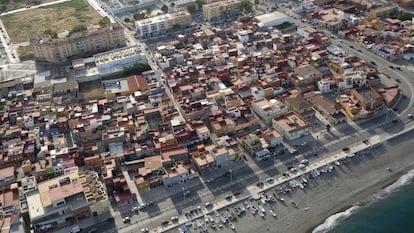
“It was in the mid-1990s. We left from La Línea de la Concepción on a rickety boat to a spot about eight miles from the island of Perejil. We shredded our hands dragging on board packages that were tied to a buoy. I made around 250,000 pesetas (€1,500). I enjoyed the sea. In 2000 I bought my first rubber with three friends for 12 million pesetas (over €72,000). It had a 250 HP engine and a GPS. Our first job was in Málaga. Then we bought the second rubber. The ball kept rolling. By the time I got serious about it, I was practically the boss. When I was boss, I started to get behind the steering wheel. The first chase with the customs people was in the daytime. I’ve never thrown packages overboard. I’ve never feared for my life. I’ve been caught three times, but they had nothing on me. My last time out was in 2008. These days I have too much to lose to do that anymore. I stopped when the coast of Morocco stopped being safe. They used to take more bribes, but now they shoot at you. It’s better to be chased by the Spanish police – by law, they cannot shoot you.”
Then he adds that the Civil Guard’s Integrated Exterior Surveillance System (SIVE) “has a blind spot from Ceuta to Gibraltar in a straight line. These days, more hash is coming in that ever. And the Civil Guard has always been an accomplice to it. With €40,000 you can buy off an entire group.”
This dealer further reveals that a variety of hashish known as jardala sells for €1,700 a kilogram, and a ton and a half for around €2.5 million. The profits are diverted to Morocco or Dubai, where there are fewer checks on the origin of money than in Spain.
If I wanted to order a shipment right now, all I would have to do is send two messages from this cellphone: one to Morocco and the other one to someone here in Spain
Costa del Sol drug boss
But even this line of business, it seems, is suffering the effects of a more open market and fresh competition. “These new kids who are going into the business are bringing prices down. You invest €500 and you make €250. Before, everything used to be more self-contained. You didn’t smuggle in the daytime. Rubber boats have always been coming out of the Guadarranque River, but the night schedule was respected. I have friends who are teaching their children the business. I wouldn’t want my kids to follow in my footsteps.”
The recent proliferation of criminal organizations that steal from one another only aggravates a situation in which drug trafficking has become a way of life for successive generations. After the Guadarranque River was blocked off with a physical barrier, smugglers found beachfront homes to keep the boats in parts of the Bay of Algeciras such as Puente Mayorga and Palmones.
Aspiring drug smugglers begin by working with tobacco. “The good ones then move on to hashish,” explains a customs officer.
Francisco Márquez, director of the Botafuegos penitentiary in Algeciras – the stopping point for many of these novices who get caught in the act – sums it up neatly: “drug trafficking is the star crime in Campo de Gibraltar.” Boat captains typically earn €50,000, scouts working on land get €1,000 to €1,500, and vehicle operators receive €3,000 for taking the load to the safe houses.
By sea and by land, everyone is fighting for control over countless tons of hashish that end up on the beaches of Andalusia each year, an area that spans thousands of kilometers from the border between Huelva and Portugal in the west to Almería’s Cabo de Gata in the east. The funnel represented by the Strait of Gibraltar is a hot spot. Once on Spanish soil, the product is stored in thousands of “nurseries” scattered along the coastline, awaiting trucks that will ship them north.
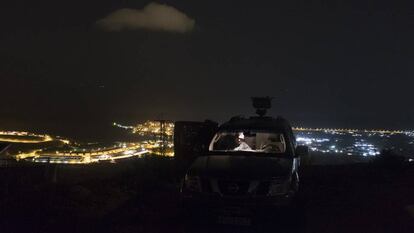
Cádiz province is the entry point for nearly half of all the hashish that is transferred to the Iberian peninsula from Morocco. And barely 20% of the total shipped is found and seized. Confiscations in 2016 reached 324 tons. And the port of Algeciras, where only five percent of containers arriving at the facility get checked, is also a major entry point for cocaine from South America.
Meanwhile, coastal communities where the drug trade flourishes, such as La Línea or Sanlúcar de Barrameda, continue to top the poverty and unemployment charts in Spain.
The business has evolved, creating professionals who will do anything to hold onto their cargo. Skilled pilots are paid handsomely, both at sea and on land. Once on the beach, the drugs are transferred to stolen vehicles and driven at top speed to the safe houses. The rule is: don’t let anything or anyone get in the way. Typically three vehicles are involved: one to pave the way, one to carry the load, and another one to ram into any police patrol bold enough to chase them.
The safe houses are equipped like fortresses, containing enough weapons to repel potential attacks by rival gangs. The settling of scores is a common occurrence. Many law enforcement officers are afraid that they will be recognized on the street. “This has turned into warfare,” says a police officer who has years of experience with this situation. “And we are losing.”
A veteran politician who serves in one of the municipalities within Campo de Gibraltar talks about the “South-Americanization” of the methods used by increasingly violent gangs. And Miguel Gil, 55, who is the operations chief at the Customs Surveillance Service, leaves no room for optimism: “We are in a state of war. And right now they are winning almost all the battles. The fear is that the organizations will evolve Galicia-style: the Campo de Gibraltar is undergoing the same evolution as the coast of Galicia [in Spain’s northwest] in the 1980s and 1990s: from tobacco smuggling they moved on to hashish, and now we shouldn’t rule out the presence of cocaine on the boats. In the last few years everything has gone from bad to worse. The police have done all they can do.”

In mid-June, the government delegate in Andalusia announced a special deployment of National Police and Civil Guard officers in La Línea to deal with the growing confrontation between drug traffickers and law enforcement. The number of officers has not been disclosed, in order to avoid “giving the bad guys clues,” according to the authorities.
People here insist that a turning point was reached on June 8, when a local police officer named Víctor Sánchez, 46, was run down and killed during a chase involving tobacco smugglers. When the International Day Against Drug Abuse and Illicit Trafficking was observed on June 26, the head of local advocacy group Coordinadora Alternativas read out a statement: “Drug traffickers are enjoying their drug money with impunity,” said Francisco Mena.
Mena insisted that law enforcement is overwhelmed, that there is a generalized feeling of impunity in the area, and that stricter regulation is required to deal with the drug boats.
“There is only one known use for them. Once confiscated, they should be destroyed so they don’t go out to auction and end up being reused. The business represents an estimated €300 million a year in Campo de Gibraltar,” he added. “The state is not the main operator here, it’s the narco-economy.”
Union representatives for the National Police, the Civil Guard and the Customs Surveillance Service (SVA) talk about their lack of resources, and note that average monthly salaries in all three agencies range from €1,300 to €1,500. They also admit that there have been isolated cases of law enforcement officers who were convicted of conniving with drug organizations.
Cádiz is the only province in Spain with three narcotics prosecutors. Emilio Miró has been heading the office in Algeciras for 16 years. “The worst situation is now in La Línea,” he says. “At sea, the inflatable boats have an edge over the patrol boats used by the customs service and the Civil Guard. But the most vulnerable point is on land, when the goods are placed inside the vehicles. That’s where the worst episodes of violence are taking place. Besides more officers, it would help to see greater cooperation among the law enforcement agencies.”
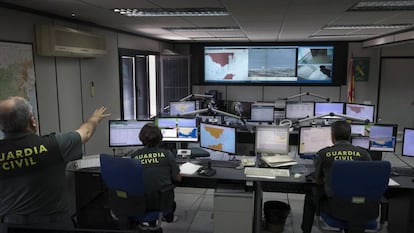
Miró admits that his own office is “partly overwhelmed.” Besides the drugs, he also pays close attention to tobacco smuggling activities originating in Gibraltar. “The volume is incredible,” he notes. “But it’s not considered smuggling until the goods reach a value of €15,000. A lot of people say they live off of this.”
“The large groups work like cartels, with many lesser gangs under their control,” reveals Miró. “The punishment is around four years and a half for belonging to an organization. But if you factor in prison benefits and subtract the time they spend in custody, convicts can get out in three to four years.”
“Perhaps outside of this place it is hard to appreciate the full impact of this problem in terms of crime and social conflict: a lot of young people see this criminal activity as a professional option,” he adds.
Close by is the port of Algeciras, which sees a million containers pass through each year. There is a technique known as the Lost Hook, whereby at least one docker who has been bought off will provide access to a specific container. This is another way in for drugs. Every day, around 50 containers go through a scanner.
“The most recent seizure was three weeks ago: 7,000 kilograms of cocaine,” says one of the officers in charge of this task. “Out of every 200 containers, one tests positive for illegal cargo.” The officers go home at 8.30pm, and the battle returns to the sea.
Inside the exclusive residential estate of Sotogrande, there is a law firm headed by the criminal lawyer Ricardo Álvarez-Ossorio. At 45, he has two decades’ worth of experience in the field and has defended drug traffickers operating in the Strait of Gibraltar, including Mohammed Taieb Ahmed, aka El Nene (The Kid), head of one of the main clans in Ceuta.

“I haven’t heard from him in years, which leads me to believe that he died. He was a courteous man, charismatic,” the lawyer recalls. “Pretty basic on issues on morality. And it was really like he had a computer inside his head.”
Álvarez-Ossorio drives into his office in a black Jaguar F-TYPE convertible. He is wearing a tight suit that reveals a gym-sculpted body. A white gold Rolex Daytona can be seen on his left wrist. He says that it does not take him long to put together a case, and that he rejects cases involving heroin, terrorism and pedophilia.
“Right now we have around 100 active cases,” he says. “Around 75% have to do with crimes involving public health and money laundering. I try to be clear with my clients: I am not the Wizard of Oz. This situation in southern Spain is like trying to empty out a pool that is always going to have water in it. The puddle will never dry up. The more hashish is seized, the more Morocco will produce.”
While the wheel keeps turning, the SIVE service at the Civil Guard Command Center in Algeciras keeps monitoring the Strait of Gibraltar. Despite the limitations, and the fact that the rock of Gibraltar remains a blind spot, SIVE’s successes are widely acknowledged by all law enforcement agencies. And relations with the police in the British Overseas Territory are described as “excellent.” This description is ratified by the chief of the Royal Gibraltar Police, Edward Yome.

Yome recalls one occasion when one of his patrols reported hearing shots in the air from a drug boat during a chase. “Our goal is to prevent those fleeing the Spanish customs officers and the Civil Guard from taking refuge in the waters three miles around the Rock,” he says. “In Gibraltar a law banned the use of rubber boats, and results have been positive.”
Evening falls on La Línea de la Concepción, population 63,000, unemployment rate 35%. The neighborhood of La Atunara, located along the shore, is something of a war zone. Special units of the National Police and the Civil Guard keep watch during the day, holding their light machine guns. “This is a neighborhood of humble folks,” says Manuel Rojas, a neighborhood representative. “But no politician has bothered to occupy himself with this remote spot. A lot of people here survive thanks to Gibraltar. I would build hotels and encourage tourism. If there are no opportunities, people will find their own way. And if they turn to smuggling, I don’t see anything wrong with that.”
“Three types of measures should be considered,” says Helenio Lucas Fernández, the social affairs councilor at La Línea. “In the short term, police measures; in the mid-term, infrastructure, and in the long term, educating people in values.”
The wheel keeps turning in Campo de Gibraltar. “And it will stay that way as long as the drug trade brings in money,” says Ana Villagómez, the narcotics prosecutor in Cádiz. “There are many open fronts. There is a shortage of police and legal resources. Investigations and arrests have gone down in number. We need more teams to go after money laundering. The system is slow and bureaucratic. I have pending cases from 2009. We cannot generalize, but in parts of the south there is a war going on. And in the hot spots, the drugs are everywhere. We’re only seeing the tip of the iceberg.”
English version by Susana Urra.


